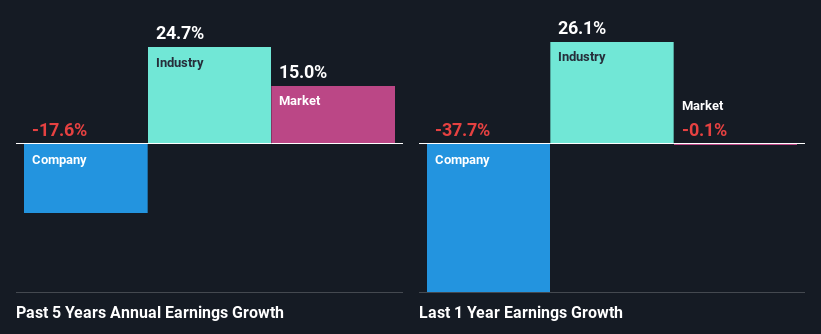Does Cleanaway Waste Management Limited's (ASX:CWY) Weak Fundamentals Mean That The Stock Could Move In The Opposite Direction?
Most readers would already know that Cleanaway Waste Management's (ASX:CWY) stock increased by 2.3% over the past month. Given that the markets usually pay for the long-term financial health of a company, we wonder if the current momentum in the share price will keep up, given that the company's financials don't look very promising. In this article, we decided to focus on Cleanaway Waste Management's ROE.
Return on Equity or ROE is a test of how effectively a company is growing its value and managing investors’ money. Put another way, it reveals the company's success at turning shareholder investments into profits.
See our latest analysis for Cleanaway Waste Management
How Is ROE Calculated?
The formula for return on equity is:
Return on Equity = Net Profit (from continuing operations) ÷ Shareholders' Equity
So, based on the above formula, the ROE for Cleanaway Waste Management is:
1.6% = AU$49m ÷ AU$3.0b (Based on the trailing twelve months to December 2023).
The 'return' is the yearly profit. One way to conceptualize this is that for each A$1 of shareholders' capital it has, the company made A$0.02 in profit.
What Has ROE Got To Do With Earnings Growth?
Thus far, we have learned that ROE measures how efficiently a company is generating its profits. Based on how much of its profits the company chooses to reinvest or "retain", we are then able to evaluate a company's future ability to generate profits. Assuming everything else remains unchanged, the higher the ROE and profit retention, the higher the growth rate of a company compared to companies that don't necessarily bear these characteristics.
Cleanaway Waste Management's Earnings Growth And 1.6% ROE
It is hard to argue that Cleanaway Waste Management's ROE is much good in and of itself. Even when compared to the industry average of 14%, the ROE figure is pretty disappointing. For this reason, Cleanaway Waste Management's five year net income decline of 18% is not surprising given its lower ROE. We believe that there also might be other aspects that are negatively influencing the company's earnings prospects. For instance, the company has a very high payout ratio, or is faced with competitive pressures.
However, when we compared Cleanaway Waste Management's growth with the industry we found that while the company's earnings have been shrinking, the industry has seen an earnings growth of 25% in the same period. This is quite worrisome.
Earnings growth is a huge factor in stock valuation. The investor should try to establish if the expected growth or decline in earnings, whichever the case may be, is priced in. Doing so will help them establish if the stock's future looks promising or ominous. What is CWY worth today? The intrinsic value infographic in our free research report helps visualize whether CWY is currently mispriced by the market.
Is Cleanaway Waste Management Making Efficient Use Of Its Profits?
Cleanaway Waste Management's high three-year median payout ratio of 129% suggests that the company is depleting its resources to keep up its dividend payments, and this shows in its shrinking earnings. Its usually very hard to sustain dividend payments that are higher than reported profits. You can see the 2 risks we have identified for Cleanaway Waste Management by visiting our risks dashboard for free on our platform here.
Moreover, Cleanaway Waste Management has been paying dividends for at least ten years or more suggesting that management must have perceived that the shareholders prefer dividends over earnings growth. Upon studying the latest analysts' consensus data, we found that the company's future payout ratio is expected to drop to 66% over the next three years. Accordingly, the expected drop in the payout ratio explains the expected increase in the company's ROE to 8.4%, over the same period.
Summary
On the whole, Cleanaway Waste Management's performance is quite a big let-down. Specifically, it has shown quite an unsatisfactory performance as far as earnings growth is concerned, and a poor ROE and an equally poor rate of reinvestment seem to be the reason behind this inadequate performance. Having said that, looking at current analyst estimates, we found that the company's earnings growth rate is expected to see a huge improvement. To know more about the company's future earnings growth forecasts take a look at this free report on analyst forecasts for the company to find out more.
Have feedback on this article? Concerned about the content? Get in touch with us directly. Alternatively, email editorial-team (at) simplywallst.com.
This article by Simply Wall St is general in nature. We provide commentary based on historical data and analyst forecasts only using an unbiased methodology and our articles are not intended to be financial advice. It does not constitute a recommendation to buy or sell any stock, and does not take account of your objectives, or your financial situation. We aim to bring you long-term focused analysis driven by fundamental data. Note that our analysis may not factor in the latest price-sensitive company announcements or qualitative material. Simply Wall St has no position in any stocks mentioned.

 Yahoo Finance
Yahoo Finance 
